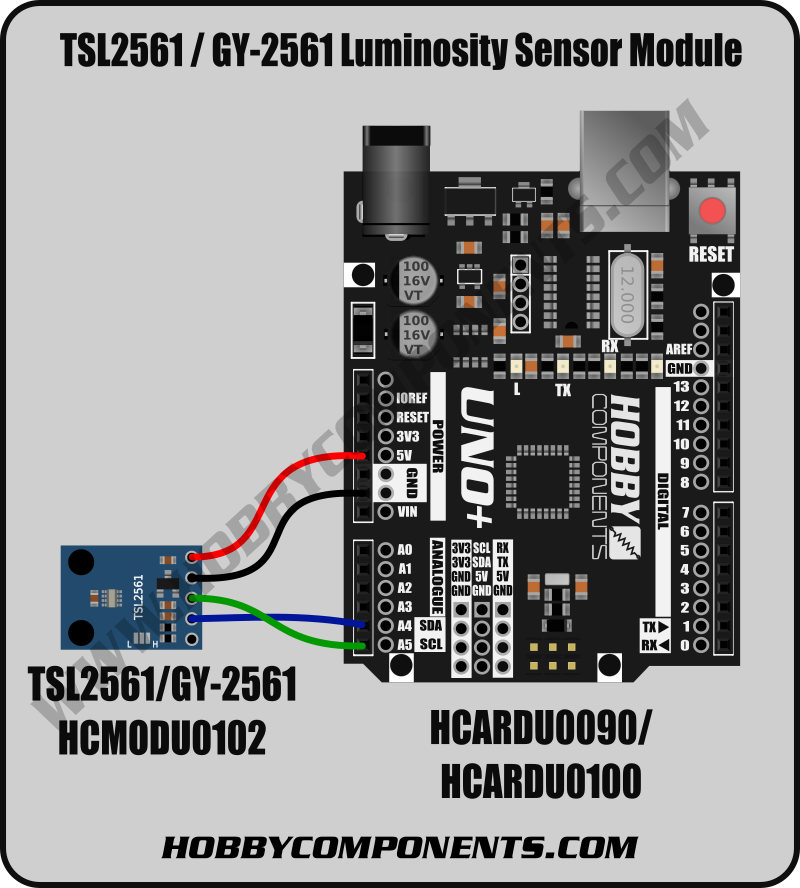W1209 Temperature control...
The W1209 is an incredibly low cost yet highly functional thermostat controller. With this...
- On sale!




The TSL2561 (HCARDU0102) Luminosity sensor module is a light to digital interface module. The sensor contains two photodiodes, one which can detect visible light and infrared (IR), and a second which can detect IR light. Two integrating analog-to-digital converters (ADC) integrate currents from the two photodiodes to produce a digital representation of the the light intensity hitting the sensor.
The TSL2561 (HCARDU0102) Luminosity sensor module is a light to digital interface module. The sensor contains two photodiodes, one which can detect visible light and infrared (IR), and a second which can detect IR light. Two integrating analog-to-digital converters (ADC) integrate currents from the two photodiodes to produce a digital representation of the the light intensity hitting the sensor. Communication to the device is accomplished through a standard, two-wire I2C serial bus. Consequently, the TSL256x device can be easily connected to a microcontroller or embedded controller. No external circuitry is required for signal conditioning. Solderable jumper pads on the module allow 3 possible I2C addresses to be selected for up to 3 sensors or other I2C devices to co-exist on the same bus. An on-board regulator means the module can be powered from a convenient 5V source.


Features:
Approximates Human Eye Response
Programmable Interrupt Function with User-Defined Upper and Lower Threshold Settings
16-Bit Digital Output with SMBus (TSL2560) at 100 kHz or I2C (TSL2561) Fast-Mode at 400 kHz
Programmable Analog Gain and Integration Time Supporting 1,000,000-to-1 Dynamic Range
Automatically Rejects 50/60-Hz Lighting Ripple
Low Active Power (0.75 mW Typical) with Power Down Mode RoHS Compliant
Power supply: 5V
Interface: I2C (0x39 default, 0x29 or 0x49 optional)
Module dimensions: 19mm x 14mm
Raspberry Pi users:
For Raspberry Pi uses we have tested this module with the free Cayenne cloud based IoT software platform. Simply connect the module to your Raspberry Pi as shown below and use the Cayenne software platform to get remote luminosity readings without writing a single line of code. 
You can create a free account simply by clicking our referral link below:
Arduino users:
To make using this module with your Arduino as easy as possible we have written an exclusive library (HCTSL2561). This library can be downloaded from the software section of our support forum here:
viewtopic.php?f=58&t=2021
The library will allow you to obtain readings from both sensors. Additionally, it can use the information from both sensors to perform a calculated Lux measurement as perceived by the human eye.
Example Arduino sketch, exclusive library and datasheet available on our support forum here.
The W1209 is an incredibly low cost yet highly functional thermostat controller. With this...
This water level sensor / float switch can be used to sense when a liquid has reached a set...
The perfect accompaniment to our Pyroelectric Infrared PIR Motion Sensor Detector Module...
This Platinum thermal resistance probe is an accurate, sensitive, and stable temperature...
The BMP180 is the function compatible successor of the BMP085, a new generation of high...
A breakout board / module for the MPU9250 9-axis (9DOF) accelerator, gyroscope, and digital...
This 16 key capacitive touch keypad is based on the TTP229 capacitive sensor with accurate...
A capacitive touch sensor module based on the dedicated TTP223 touch sensor IC. The module...
Photoresistive light dependent resistor module. Keyes brand KY-018. This module allows for...
A side mounted waterproof float switch (HCSENS0015) which uses a magnet embedded in the float,...